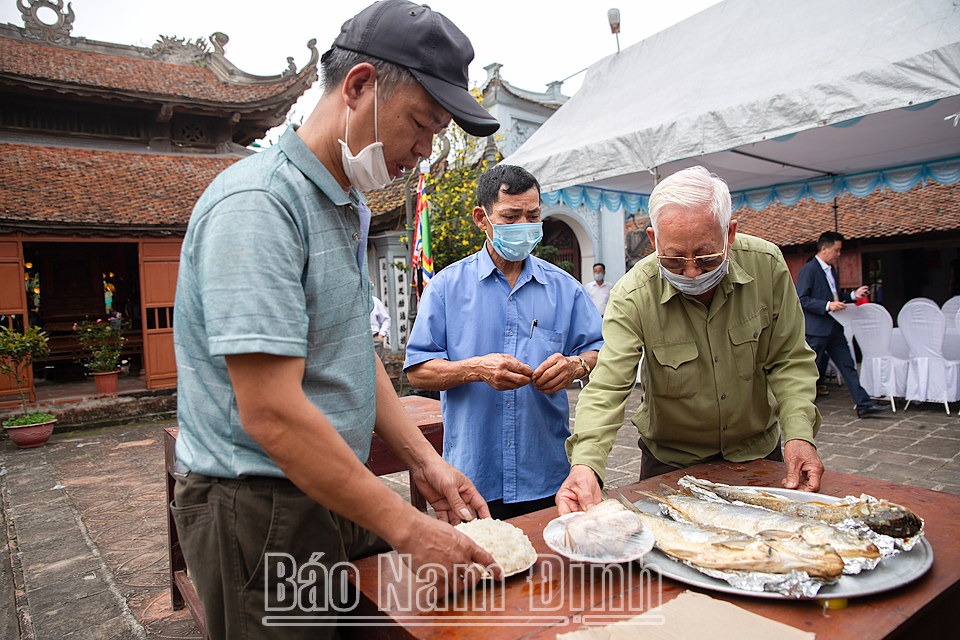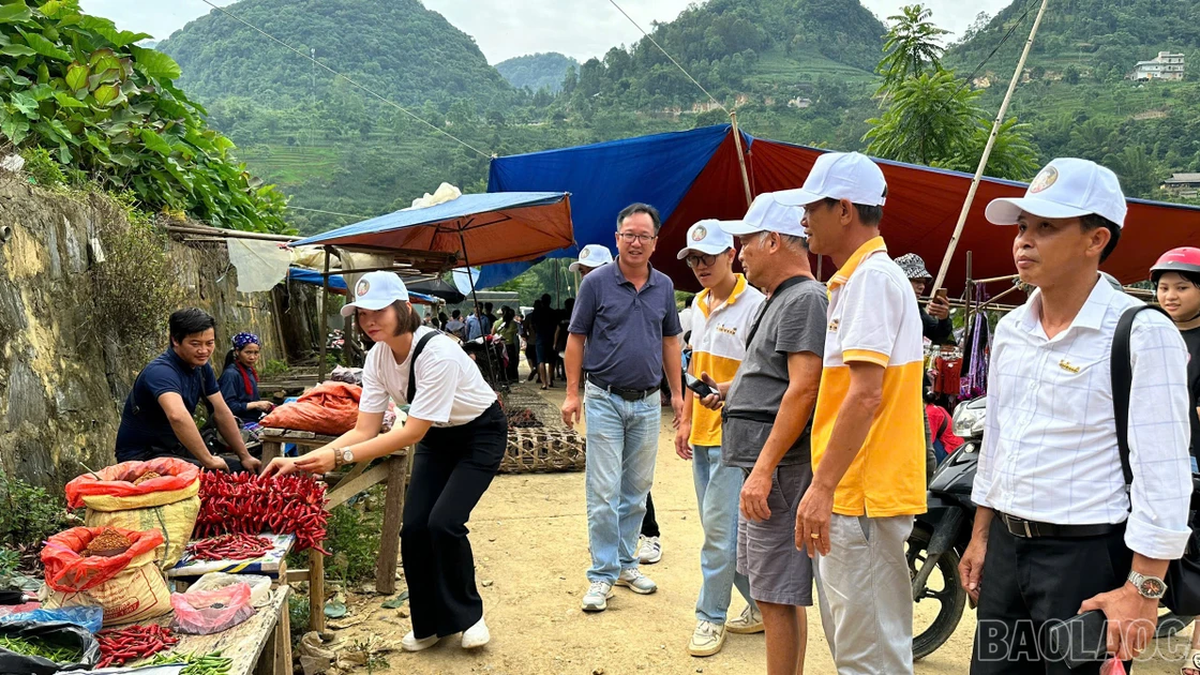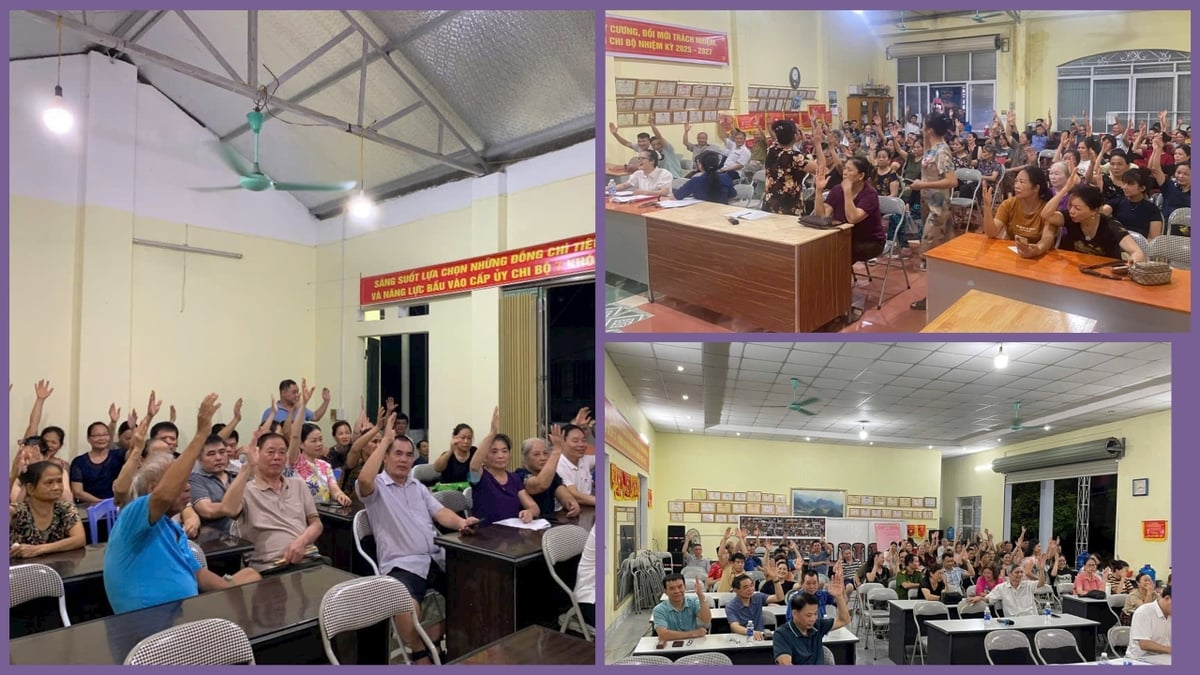 |
| Elders prepare fish offerings to the Saints at the Gin Temple festival, Nam Duong commune (Nam Truc). |
The essence of the offering to the Saints
Gin Temple is a place to worship the holy Long Kieu Cong Han, who helped Ngo Quyen defeat the Southern Han army on the Bach Dang River in 938. The Gin Temple Festival takes place from the 8th to the 10th of the 12th lunar month every year, attracting a large number of people from Nam Duong and Binh Minh communes (Nam Truc) to attend. The unique feature of the Gin Temple Festival lies in the elaborate offerings, in which the savory dishes cannot lack 8 types of traditional hams including: head ham, leaf ham, leg ham, flower ham, offal ham, pomegranate ham, silk ham and ham. These hams are elaborately prepared by the people of Voc residential area, Phuc Thien village, with the talented hands of artisans. Among them, there are 3 typical artisans: Pham Van Minh, Tran Van Lang, Tran Van Huan who are still diligently preserving and passing on the family secret. From the stage of choosing ingredients to the arrangement, marinating, boiling and pressing of hams, all are done meticulously and elaborately. The secret of each type of ham lies in the selection of ingredients and the traditional recipe. Head sausage is made from the pig's head. The craftsman thoroughly boils the meat, snout and ears, then separates the skin and fat. When arranging the ham, the boiled egg yolk is placed in the middle as the focal point, surrounded by alternating pieces of skin, creating a unique pattern. Similarly, pork offal sausage uses pig organs combined with ground lean meat; thanks to the skillful arrangement, when cutting the ham, there is a "banh bia" (stuffed pork sausage) in the middle and the heart and liver arranged around it, creating a beautiful shape. Pork offal sausage is made from tightly rolled fat and belly skin; when boiled and pressed, each block of ham shows decorative veins. Pork leg sausage, silk sausage, and pomegranate sausage are types of sausage made from lean meat. Pork leg sausage uses carefully deboned pork thigh, pressed tightly into a solid block; silk sausage is made from finely ground, smooth, white lean muscle meat; pomegranate sausage uses small, square pieces of fat, mixed with ground lean meat. After boiling and pressing, each type of ham has a uniform color, rich sweetness and moderate softness. Each type of ham, though simple, contains a delicate flavor, preserving the soul of the countryside in the sacred offering tray.
The flipped leaf ham and the flower ham are considered miniature works of art. When making the flipped leaf ham, the artisan skillfully cuts the meat into thin, even “leaf petals”, interspersed with layers of golden omelette; each ham has nine cuts on each “leaf petal”, symbolizing longevity and luck. When boiled and pressed, the ham mold combines the layers of meat and egg to form a brilliant leaf shape in the center of each ham. The flower ham stands out because the core of the ham is shaped into numbers symbolizing the year of the Saint’s sacrifice; when slicing each slice, the neat floral patterns are clearly visible, as if marking the sacred time of the festival.
Before each festival season, artisans often fast, clean their tools and prepare carefully as a solemn ritual. Their skillful hands both preserve the secrets of their ancestors and breathe life into the dish, turning the steps of filtering meat, marinating spices, boiling the ham and wrapping the ham in banana leaves into a work of culinary art. In the solemn atmosphere of the festival, each piece of ham offered to the Saint is imbued with sincerity, expressing the morality of "eating the fruit, remembering the person who planted the tree", contributing to creating a cultural beauty that has been preserved through many generations.
Rich in hometown flavor
Not only famous for its ham dishes, Phuong village, Nam Duong commune is also known for its traditional craft of making dong vermicelli and rice paper. In the past, this craft only helped people improve their daily income, but in recent years, making dong vermicelli and rice paper has become the main source of livelihood for many families. The whole village has dozens of households producing dong vermicelli and rice paper, creating jobs for hundreds of seasonal workers and bringing in a stable income. The white rice vermicelli, chewy dong vermicelli and fragrant rice paper of Phuong village have become a popular brand throughout the Northeast and Northern coastal regions.
The process of making dong vermicelli in Phuong village harmoniously combines tradition and modernity. After being soaked and washed, the arrowroot flour (arrowroot starch) is put into a machine to form thin sheets of cake, then steamed. When cooked, the surface of the vermicelli cake is clear white, and is dried under the hot sun to drain the water; then, the worker puts the cake into a cutting machine, creating long, even vermicelli strands. Thanks to the secret of fermenting the flour and the traditional drying process, the vermicelli strands are naturally clear, smooth, and chewy. In recent years, Phuong village has adopted technology to improve productivity. Many households have invested in flour mills, automatic coating machines, and cutting machines. Each vermicelli factory can produce 200-300kg/day. Thanks to that, the income from making vermicelli has increased significantly, helping people improve their lives. The story of "morning sun vermicelli, afternoon wind vermicelli" has become a daily joy, when the delicious vermicelli strands are dried at the right time, creating a unique flavor that cannot be found anywhere else. Along with vermicelli, the rice paper making profession in Phuong village also bears the mark of the homeland. Unlike many places that add turmeric to the dough to create color, Phuong rice paper only uses pure rice flour and black sesame. The worker kneads the dough, rolls it thinly and grills it over hot coals; when the surface of the cake turns golden brown and crispy, he flips it over to the other side. The rice paper after baking is crispy for a long time, the rich taste of rice blends with the aroma of sesame. That crispy and fragrant flavor has become a hometown specialty, making Phuong rice paper popular in many neighboring places. Today, vermicelli and rice paper products from Phuong village are exported to all provinces and cities: Hanoi, Hai Phong, Thai Binh, Lang Son, Quang Ninh and even some provinces in the Central and Southern regions. The traditional profession brings in a significant source of income, contributing to poverty reduction and promoting local economic development. During the harvest season, hundreds of rural workers have stable jobs from the stages of fermenting dough, making rice paper, drying vermicelli, and baking rice paper. In 2013, Phuong village was recognized as a provincial traditional craft village. The quintessence of Nam Duong cuisine through the white vermicelli and crispy rice paper continues to be passed down from generation to generation, a testament to the steadfast heart and eternal desire of many generations of Nam Dinh people.
Comrade Pham Quang Khai, Chairman of Nam Duong Commune People's Committee, said: Over the years, the local Party Committee and government have always paid attention to preserving and promoting traditional cultural values, including culinary heritage and traditional occupations such as making ham offerings to the Saints, making dong vermicelli, and rice paper. In addition to supporting the recognition of craft villages and organizing activities to preserve the Gin Temple festival, the commune also creates conditions for production households to access loans, expand their scale, apply machinery, and improve product quality. This is not only a way to preserve the identity of the homeland but also contributes to promoting sustainable socio -economic development.
Article and photos: Viet Du
Source: https://baonamdinh.vn/dat-nuoc-con-nguoi/202506/dac-sac-am-thuc-nam-duong-68445e6/




































































































Comment (0)